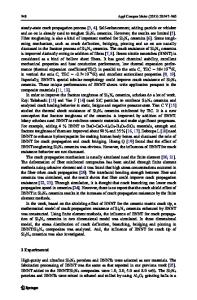Deformation and microstructural changes in SiC whisker-reinforced Si 3 N 4 composites
- PDF / 7,041,053 Bytes
- 12 Pages / 576 x 792 pts Page_size
- 14 Downloads / 303 Views
K. L. More High Temperature Materials Laboratory, Oak Ridge National Laboratory, Oak Ridge, Tennessee 37831-6064
R. F. Davis Department of Materials Science and Engineering, North Carolina State University, Box 7907, Raleigh, North Carolina 27695-7907 (Received 22 January 1991; accepted 22 July 1991)
Constant stress compressive creep studies have been conducted on hot-pressed Si 3 N 4 containing 30 vol. % SiC whiskers and an initial vitreous phase composed of A12O3, Y 2 O 3 , and SiO 2 . The conditions of temperature and stress were 1470-1670 K and 50-350 MPa, respectively; the atmosphere was purified N 2 at 1 atm. Significant changes in the stress exponent and activation energy indicate a change in the controlling creep mechanism at «s225 MPa and 1570 K. Prolonged annealing in the unstressed condition reduced creep rates but had little effect on the stress exponent values. Transmission and scanning electron microscopy revealed that the break in the stress exponent curves was caused by the removal of the amorphous material at the grain boundary and resulting contacts between S13N4 grains. The break in the activation energy curves is believed to be similarly related. Analysis of all the data indicates that the composite creeps via grain boundary sliding accommodated by viscous flow at low stresses and temperatures and by diffusion at high stresses and temperatures. The contributions of these two mechanisms varied measurably as a function of stress and temperature. No cavitation was observed. The presence of the SiC whiskers had no observable effect on deformation.
I. INTRODUCTION As a result of the observed increases in room temperature fracture toughness and strength,1'2 hotpressed Si 3 N 4 containing SiC whiskers has been proposed as a candidate material for structural applications at elevated temperatures. However, investigations of the high temperature behavior of this composite have been limited.3"7 Electron microscopy3'4'8"11 and deformation3'4'12"16 studies conducted on unreinforced, hot-pressed silicon nitride have shown that the high temperature strength may be compromised by the presence of an amorphous grain boundary phase that softens on heating. This phase is composed of various oxides such as MgO, Y 2 O 3 , and A12O3 (added to assist densification during hot-pressing) and the native SiO2 already present on the Si 3 N 4 and SiC surfaces. Crystallization of this phase improves the high temperature strength of these materials.17"20 This finding is supported by the grain boundary sliding models, proposed by most investigators,12'14"16 since crystallization of the boundary phase would increase its effective viscosity. Lange and co-workers14 and Pasto et al}5 also observed cavitation in extensively deformed samples. J. Mater. Res., Vol. 6, No. 12, Dec 1991
http://journals.cambridge.org
Downloaded: 19 Mar 2015
Nixon et a/.3-4 have investigated the constant compressive stress creep behavior in N 2 of hot-pressed unreinforced Si3N4 and 20 vol. % SiC whisker-reinforced Si 3 N 4 , both containing A12O3 and
Data Loading...











